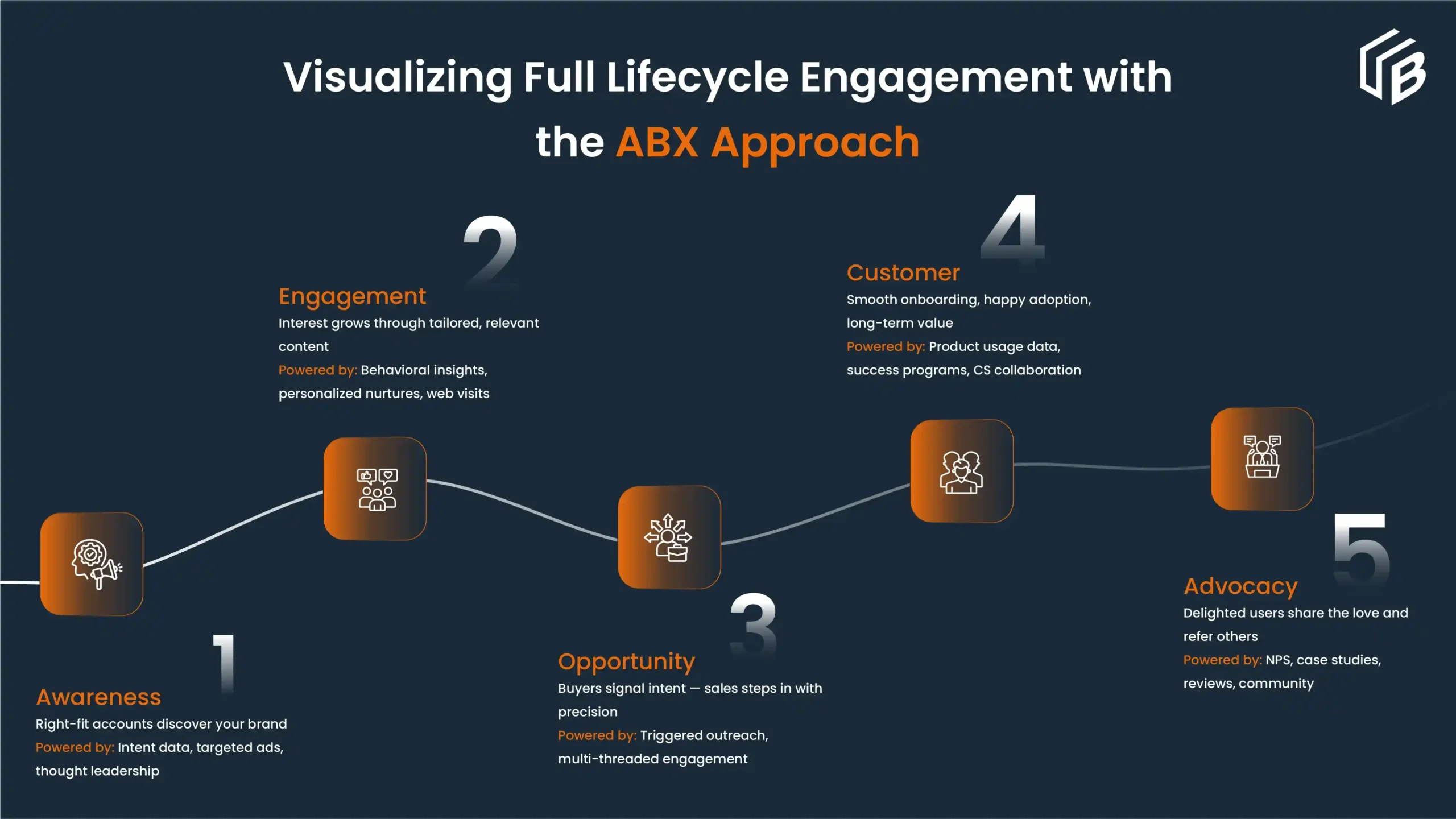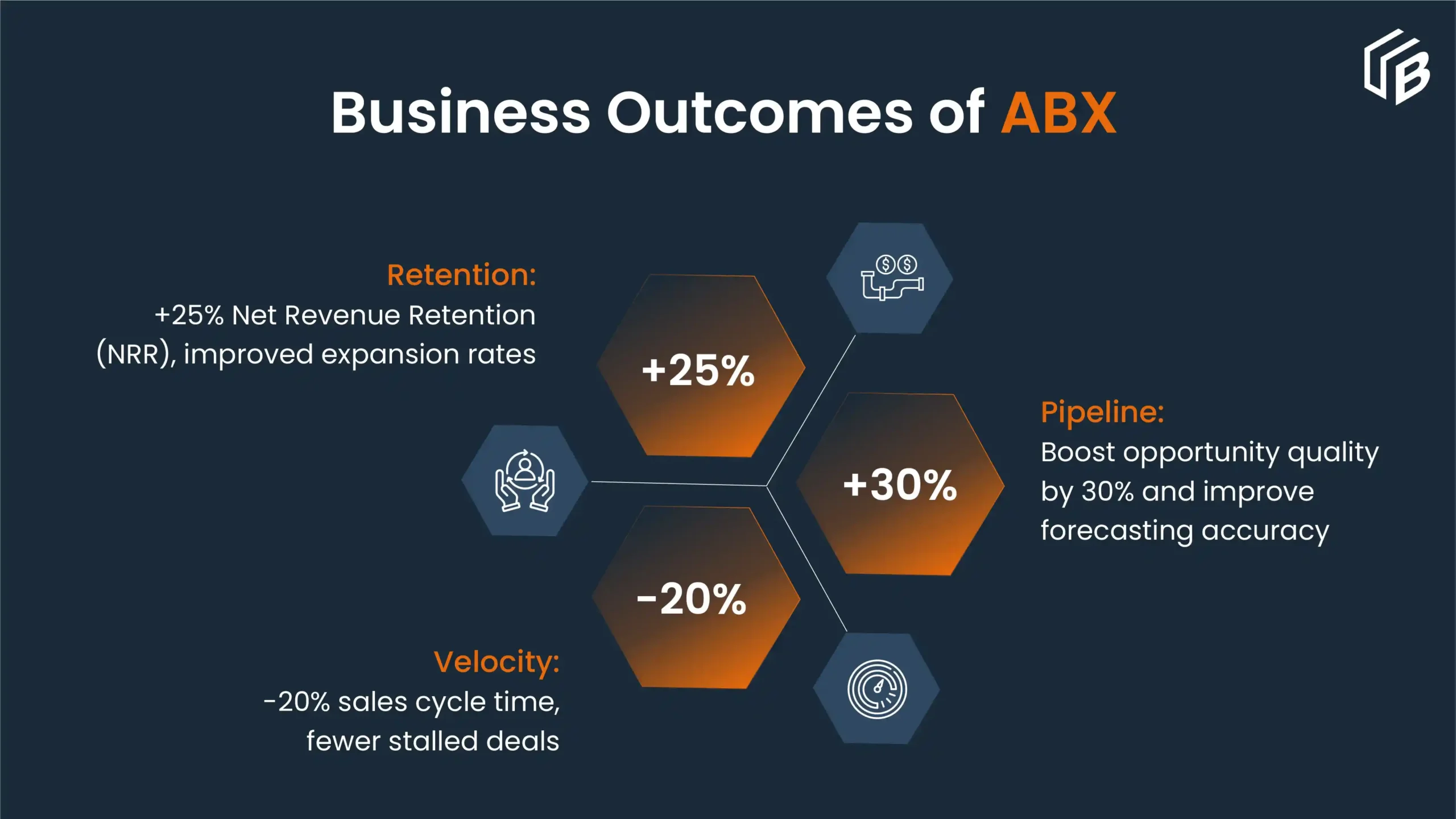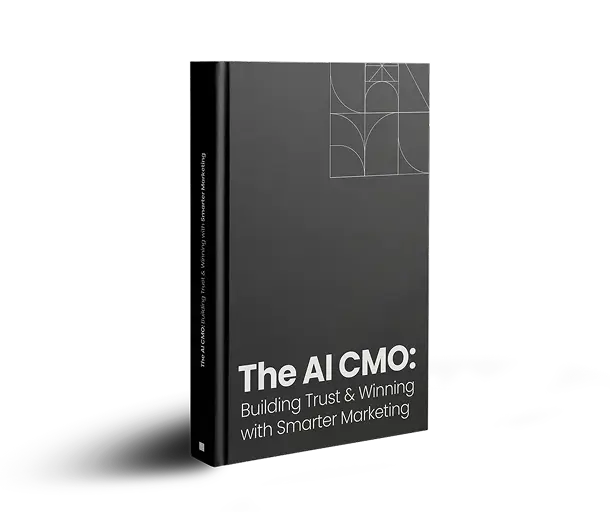
For years, Account-Based Marketing (ABM) has served as a cornerstone of high-performing B2B go-to-market strategies. Its precision targeting and alignment around key accounts helped organizations streamline resources and drive measurable ROI. But as buying behaviors and digital experiences evolve, ABM as we know it is no longer enough. The modern B2B buyer expects more relevance, more coordination, and more personalization.
ABX is the strategic evolution of the ABM. Where ABM emphasized account targeting and campaign delivery, ABX takes a broader, more integrated view. It blends account intelligence, real-time signals, cross-functional alignment, and personalized experiences across the entire customer journey.
The key difference between ABM and ABX lies in execution and impact. Rather than replacing ABM, ABX represents the next stage of growth for organizations ready to deepen customer engagement and operationalize a more holistic go-to-market strategy.
It unifies revenue teams (marketing, sales, and customer success) to orchestrate meaningful engagement from first touch to post-sale expansion. This shift from marketing-led campaigns to revenue-led experiences is what sets ABX and traditional ABM apart.
ABX in Action: What Changes from Traditional ABM
To understand the shift, consider the following comparison between ABM vs. ABX:
| Component | Traditional ABM | ABX Marketing |
| Data | Static firmographic lists | Unified, real-time intent + engagement |
| Campaigns | Scheduled and outbound-heavy | Responsive, omnichannel experiences |
| Journey Mapping | Linear and segmented | Dynamic, full-funnel orchestration |
| Team Collaboration | Marketing-led with sales buy-in | Unified GTM teams across the funnel |
| Metrics | MQLs, CPLs, CTR | Revenue moments, pipeline velocity |
The Account-Based Experience strategy represents three fundamental shifts:
- From campaigns to real-time experiences – ABX listens and adapts continuously rather than deploying one-size-fits-all messaging.
- From static lists to dynamic signals – Buying intent, engagement behavior, and firmographic changes drive ongoing prioritization.
- From MQL handoffs to continuous revenue motion – Sales, marketing, and success collaborate on every account phase to drive outcomes.
Inside the ABX Marketing Framework
The ABX marketing framework brings structure to this dynamic approach. It comprises four strategic pillars:
1. Unified Data & Intent Signals
ABX begins with a single, enriched view of the account pulling in firmographics, engagement signals, third-party intent, CRM activity, and more. This unified foundation powers better prioritization and personalization.
2. Omnichannel Orchestration
Buyers engage across email, web, social, and sales interactions. ABX ensures these touchpoints are connected and cohesive, delivering a consistent experience regardless of entry point.
3. Real-Time Personalization
Dynamic content, adaptive messaging, and contextual engagement help each buyer feel understood and valued. This turns static ABM messaging into meaningful, relevant conversations.
4. Full-Funnel Metrics
ABX goes beyond vanity metrics. It tracks pipeline creation, deal acceleration, revenue expansion, and post-sale satisfaction of capturing the entire customer lifecycle.
These components create a closed-loop ABX marketing framework that drives sustained growth through continuous, relevant engagement.

Many organizations use a maturity model to assess progress from siloed ABM efforts to integrated and full-funnel ABX operations.
With each stage informed by data and powered by cross-functional collaboration, the ABX approach ensures no value is lost between handoffs.
At UnboundB2B, we’ve seen firsthand how ABX drives measurable results across the GTM engine. As a revenue acceleration partner for high-growth B2B companies, We leverage ABX to support clients through every stage of the funnel. With the combination and usage of intent data with real-time buyer signals, we activate full-funnel ABX experiences: from top-of-funnel education to mid-funnel acceleration and post-sale nurturing.
For example, marketing and sales teams now co-orchestrate campaigns using real-time behavioral data, allowing them to engage more effectively throughout the buyer journey. As buying signals shift, outreach efforts are dynamically adjusted to stay relevant and timely. At the same time, customer success teams are brought in earlier to help identify expansion opportunities, ensuring a more seamless and aligned experience across the entire customer lifecycle.
The result? More meaningful engagement, higher win rates, and stronger lifetime value. This approach transforms traditional ABM campaigns into living, breathing programs that adapt to buyer behavior, align with sales goals, and drive sustained growth.
Now the question rises – How ABX Gets You Qualified Accounts, Not Just Leads?
Traditional GTM processes and martech stacks have long centered around the individual lead. The goal has been to nurture leads through the funnel until they qualify as MQL, at this stage, they’re handed off from marketing to sales. But in every complex B2B deal, there are multiple stakeholders involved: the decision-maker, the end user, the influencer, the CFO, the procurement department, and so on.
According to Gartner and CEB, the average B2B buying committee includes 5.4 stakeholders, and for enterprise tech deals, that number can exceed 12. This isn’t “business-to-lead.” It’s business-to-account.
While most B2B sales teams naturally think in terms of accounts, marketing has historically focused on leads. ABM was the first step to bridge this gap which is to shift marketing efforts to align around target accounts. But traditional ABM often relied on static account lists and outbound-heavy campaigns that weren’t always aligned with where the buyer was in their journey.
Why ABX Works: The Business Impact (Pipeline, Retention, Velocity)
The promise of ABX isn’t just strategic alignment or improved buyer experiences, it’s tangible business impact. When implemented effectively, ABX strategies aren’t just the right approach for the buyers, it performs better for the businesses too.
Let’s explore how ABX directly drives outcomes across pipeline generation, sales velocity, and customer retention.

1. Stronger, More Predictable Pipeline
Traditional ABM often struggles to convert targeted outreach into a qualified pipeline. Campaigns can generate engagement, but without the right timing, personalization, or stakeholder alignment, that activity may never translate into a meaningful pipeline.
ABX solves for this by:
- Using real-time intent and behavioral signals to identify buying readiness.
- Activating multi-threaded engagement across the account to bring multiple stakeholders into the conversation.
- Orchestrating experiences that guide buyers, rather than chasing them with isolated touchpoints.
As a result, ABX-driven programs tend to generate fewer, but far higher-quality opportunities, with a significantly better chance of closing.
Business outcome: Higher pipeline efficiency, better forecasting accuracy, and greater return on marketing investment.
2. Faster Sales Velocity Through Better Orchestration
Even when ABM efforts generate high-quality leads, they can often get stuck in slow-moving sales cycles. This friction is typically due to disconnected handoffs between marketing and sales, unclear buyer intent, or misalignment on messaging.
ABX addresses this by:
- Equipping sales with up-to-the-minute insights on buyer behavior, engagement history, and content consumption.
- Enabling orchestrated outreach, where marketing, sales, and SDRs work from a shared playbook.
- Triggering contextual, relevant interactions that align with where the account is in their buying journey.
This unified approach reduces wasted effort, eliminates guesswork, and empowers sales teams to move deals forward with precision and confidence.
Business outcome: Shorter sales cycles, reduced stall rates, and more consistent deal progression.
3. Higher Retention and Customer Lifetime Value
ABX extends beyond acquisition . In fact, one of its most powerful contributions is to post-sale growth and customer retention.
By maintaining engagement across throughout the customer lifecycle, ABX ensures that:
- Customer success teams have a 360-degree view of account activity, enabling proactive support and expansion.
- Personalized experiences continue after the sale, building loyalty and reducing churn.
- Cross-sell and upsell motions are triggered by behavior, not guesswork, increasing their effectiveness.
With ABX, the same experience-first principles that drive pipelines also power loyalty, customer advocacy, and long-term revenue growth.
Business outcome: Increased Net Revenue Retention (NRR), higher customer satisfaction, and more scalable growth from your existing customer base.
In short, ABX works because it turns strategy into measurable impact. By closing the gaps between intent, engagement, and execution, it enables B2B organizations to build pipelines faster, win more deals, and grow customer value more predictably.
Success today isn’t about doing more, it’s about focusing on what matters most, delivering it at the right time, to the clientele who matters most.
Shifting from ABM Campaigns to an ABX Operating Model
Transitioning to ABX doesn’t require dismantling your ABM foundation instead, it builds on it. Here’s how to evolve:
1. Assess Your Current ABM Gaps
Evaluate where engagement stalls, data is siloed, or handoffs are failing. These are ripe for ABX improvement.
2. Map Internal Alignment Across GTM Teams
Effective ABX implementation demands joint ownership across marketing, sales, and success. Build shared KPIs and regular alignment cadences.
3. Reimagine Success Metrics
Shift from MQLs and lead scores to revenue moments: meetings set, opportunities influenced, accounts expanded.
4. Pilot ABX Tactics
Try real-time personalization on target accounts, or sync intent data into your CRM for smarter prioritization.
5. Embrace Change Management
Leadership buy-in, clear communication, and cross-functional training are essential for ABX adoption. It’s a shift in mindset, not just process.
Is Your Organization Ready for ABX?
With the integration of customer experience principles into account-based strategies, Account-Based Experience (ABX) enables organizations to engage buyers with greater precision, stronger alignment, and measurable impact on pipeline and growth.
In the realm of content saturation and shrinking buyer attention spans, ABX ensures your brand shows up at the right time, with the right message, for the right stakeholders.
B2B growth is no longer driven by lead volume or broad campaigns—it now depends on relevance, strategic alignment, and orchestration across teams. ABX is purpose-built to meet these demands.
This shift from ABM to ABX isn’t just a marketing trend—it’s a strategic response to how modern B2B buyers research, engage, and purchase. It unifies data, cross-functional teams, and technology to deliver seamless, high-value buyer journeys.
If your ABM programs have plateaued or your revenue teams are seeking deeper collaboration, now is the time to explore ABX as your next strategic move.
Our blog
Latest blog posts
Tool and strategies modern teams need to help their companies grow.

Discover the top 10 B2B appointment setting companies in the USA offering expert-led,...

Discover how AI Overviews are transforming B2B demand generation and how marketers ca...

Optimize your MQL to SQL process with AI-driven scoring, unified alignment, and best ...





